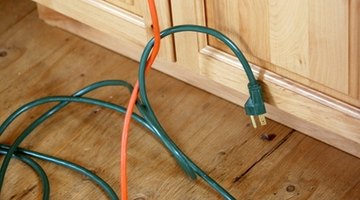How to Run a Generator Cord Through a Wall
Portable generators can power vital appliances during power outages and keep basic necessities usable. Care must be taken to ensure safe usage of generators to prevent any accidents. Running a generator power cord through a wall to the inside of a house can power appliances inside the house while keeping the generator outside. Generators should only be hooked into the main power supply of a structure if first connected to a properly installed open transfer switch.

-
Determine a safe location for the power cord to enter the house. This should be close to any appliances that will need power but far enough away from any outlets or power switches to avoid existing cables.
-
Use the electronic stud finder to locate a space between two studs in the wall. Mark this space using the pencil on both sides of the wall, centering the mark between two studs to line up the interior and exterior holes.
-
Shut power off to the room where the cable will enter using the fuse box to eliminate the danger of electrocution. Even if power is currently out to the house, shutting it off at the source will prevent any danger should it come back on while drilling.
-
Use the wireless power drill with 3" bit to drill through the outer and inner walls, being careful to drill only as far as necessary to create a hole through the outer layer of the wall. Do not try to drill all the way through the wall from one direction. Drill from both sides to reach the wall interior space.
-
Feed one end of the extension cord through the newly created hole. Any insulation in the way may be pushed to the side using a long screwdriver. Always wear work gloves, a dust mark, and safety goggles when working with insulation. One end of the cord will be outside by the generator while the other will be inside.
-
Ensure that the extension cord will reach any appliances requiring power in the event of a power outage. If using a power splitter, check that it is rated to handle the voltage produced by the generator. OSHA regulations require that a generator be connected to a properly installed open transfer switch before being connected to the power supply of a house. Do not connect the generator directly to the power supply.
-
Use the sealant foam to fill any extra space surrounding the extension cord on the exterior of the house.
-
Use the wood putty or other appropriate sealant to fill any extra space around the extension cord on the interior of the house.
References
Tips
- If at any point this process becomes uncomfortable, consult a licensed electrician before proceeding.
- If drilling through a surface other than wood use an appropriate drill bit for that material. Masonry bits work well for most types of brick and cement construction.
Warnings
- Ensure that all power is shut off to the area in which you are working to prevent accidental electrocution.
Writer Bio
Ryan Anderson began writing professionally in 2010, focusing on home improvement and business. He is currently a senior at a small liberal arts college in the Northwest. He is majoring in business and international economics and will be graduating in the spring of 2011.
Photo Credits
- Power Cords image by Towards Ithaca from Fotolia.com
More Articles



